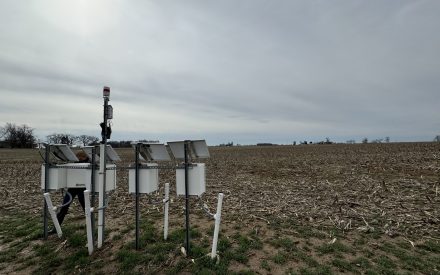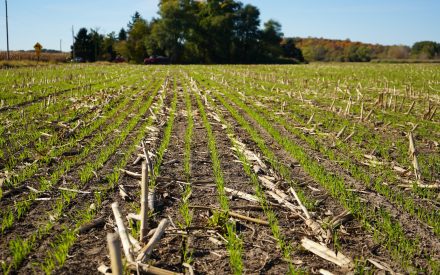Permanent Link: http://digital.library.wisc.edu/1793/95126
Tile drains play an important role in Wisconsin’s agricultural production systems. Drains alleviate saturated soil conditions, maintaining optimal root zone moisture for plant growth. Saturated soils can kill or damage crops by depriving roots of oxygen. Saturated soils also delay field access and can increase soil compaction if fields are worked. Water-logged soils can cause denitrification, the process where soil bacteria convert nitrate to nitrogen gas, thereby decreasing available nitrogen for plants. Regular maintenance of tile drains is an important management practice to ensure agricultural productivity on tile-drained land in Wisconsin.

Figure 1: Tile outlet with a rodent guard
The purpose of this publication is to:
- provide information on inspecting and maintaining tile drainage systems and
- present issues to consider when modifying existing tiles or installing new drains.
“Tile drainage systems should be inspected annually, preferably at peak flow times that typically occur during spring melt and after heavy rainfall events.”
Maintaining Tile Drains
Tile drainage systems should be inspected annually, preferably at peak flow times that typically occur during spring melt and after heavy rainfall events. Inspection should include checking outlet pipes to ensure that rodent guards are in place and working properly (Figure 1). Rodent guards prevent nests and debris introduced by rodents from plugging tile outlets. A tile outlet with a rodent guard can be quickly cleaned by sliding your hand inside the pipe under the guard and removing any trapped material. Tile outlets should also be inspected for excessive erosion and broken or crushed pipe. A good indicator of tile drain performance is a change in field moisture conditions, such as when traditionally well-drained areas exhibit prolonged periods of wetness. In this case the tile line should be inspected for a possible mid-field blockage and to verify that an adequate outlet (i.e. conveyance and capacity) exists.
Ongoing maintenance of fields and waterways with tile systems should include visual observations for animal burrows, tile blowouts or sink holes. These features range in size from a few inches to several feet and can be hard to find. The direct pathways created by these features can result in large amounts of sediment, debris, manure, fertilizer or chemicals entering tiles. Blowouts result from excessively high flow velocity or pressure inside the tile, causing it to crack or burst. Blowouts are common at tile junctions, fittings or weak spots. Blowouts will often create a sink hole when the surrounding material is drawn into the tile and transported downstream (Figure 3). During high flow periods, water rises and falls within the sink hole. During low and no flow periods, the sink hole is empty. (Figure 2). Blowouts should be repaired promptly by knowledgeable individuals. Improper repairs and quick fixes can result in ongoing problems with blockages. Always contact Digger’s Hotline, 1-800-242-8511, prior to excavation for tile repairs.

Figure 2: Sinkholes caused by tile blowout.
The most essential requirement for any drain system is an unobstructed and properly installed outlet. Drain tiles typically discharge into open ditch systems, which eventually flow into larger bodies of water, such as streams and rivers. The tile outlet to a ditch should be located approximately one foot above the normal ditch water level, allowing water to fall freely into the ditch to prevent erosion of the stream bank. Drainage ditches should be regularly inspected for excessive vegetation growth, erosion and sediment accumulation, and maintenance should be conducted as needed. Maintenance typically includes removal of trees, brush and other debris from the drainage ditch. Other maintenance practices, such as sediment excavation, will occur less frequently. Prior to conducting maintenance of larger drainage ditches, determine if the ditch in question is part of the public drainage system or drainage district (Wis. Stat. Chapter 88). Should this be the case, any maintenance must be approved and may be paid for by the drainage district board. For assistance in determining if a ditch is part of a drainage district, contact the State Drainage Engineer at the WI Department of Agriculture, Trade and Consumer Protection. Due to the potential for tile systems to drain protected wetlands, several regulatory agencies have jurisdiction over drainage projects (tile and ditch maintenance). Agencies to contact prior to construction include your county planning and zoning department, the local WI Department of Natural Resources and the USDA – Natural Resources Conservation Service (NRCS) field offices. Violation of wetland conservation laws can result in enforcement action. In the case of NRCS, violations can result in ineligibility for USDA programs.





Figure 3: Sequence of steps forming a sinkhole from a tile blowout.
Another important issue effecting tile performance is iron ochre growth. Iron ochre is a red, yellow or tan gelatinous material that adheres to drain wall openings or forms around the outside of the buried portion of the drain tile and obstructs flow. Ochre is a filamentous bacterial slime composed of organic masses and iron oxides formed by specific types of bacteria whose growth is supported by the presence of soluble (ferrous) iron in ground water. Iron ochre formation is most common in sandy and organic muck soils (Ford and Harmon, 1993). Alternately wet and dry soils, such as those under irrigation, are also susceptible to ochre formation. Soluble iron forms in soils under anoxic (non-oxygenated) conditions, which can occur under flooding and high water tables. Since subsurface drain outlets are typically open to the atmosphere, soils around drains are aerobic (contain oxygen) at low levels. As groundwater enters the aerobic zone in and around the drain, solid iron precipitation occurs, creating optimal conditions for ochre growth. Ongoing maintenance is the only economical option for controlling iron ochre formation. If iron ochre has formed on plastic drain tiles, high and low pressure water jet cleaning is the most cost-effective management option. Higher pressure ( > 400 psi) can be used with larger drain tile perforations or when drains are enveloped in gravel. Lower pressure ( < 400 psi) should be used in sandy soils, when drain tile perforations are small, or when a synthetic sock is used to envelop the tile (Ford and Harmon, 1993).
Modifying or Installing New Tile Drainage Systems
NRCS standard practices (NRCS Code 606) should be followed when designing, modifying or installing tile drainage systems (NRCS, 2002). A detailed installation plan should be developed addressing specific drainage needs. Preparation of this plan requires assistance from knowledgeable individuals, such as an engineer or experienced tile installer, and should consider crop and soil types as well as site topography. A sub-surface drain system is composed of lateral, sub-main and main line piping. Laterals are the initial collectors of excess water from the soil. Several laterals convey flow to a main or sub-main. A sub-main carries flow to a main line that typically drains to the outlet (Figure 4). When enlarging lines or adding new laterals to existing drainage systems, be certain main lines are adequately sized to accommodate the additional flow, thus avoiding back pressure and blowouts. Air vent installation is recommended to maintain atmospheric pressure through out the system. This allows for maximum flow capacity and relief from back pressure conditions.

Figure 4: Typical tile drainage system components.

Figure 5: Tile vent installed at field edge.
Tile system vents are open at the ground surface in order to expose the system to the atmosphere (Figure 5). Vents should protrude above the ground approximately one foot to minimize clogging. They are commonly placed in low traffic areas (e.g. along fence rows), making them difficult to locate. If your system has vents they should be located, mapped, inspected and cleared of obstructions. Some (typically older) tile systems may not have vents. Tile flow rates and water level inspection can be conducted through a vent opening with a flashlight. Also note that because tiles lines located within 80 feet of trees may have flow obstructed by tree roots entering the line, tiled waterways and buffers should be kept clear of trees.
Good record keeping is an essential part of any drainage maintenance program. The location of tile lines, vents, surface inlets and outfalls is critical for troubleshooting and design modifications. Modern GPS technology has become an indispensable tool for mapping tile lines. Tile system mapping should be conducted when new tiles are installed and whenever information becomes available for existing systems (e.g. during routine maintenance). Tile location records should be stored in a safe, readily accessible location.
Summary
Functioning tile drains are essential to crop productivity and water quality in some parts of Wisconsin. Important actions to take when inspecting your tile drain system include:
- Clear obstructions from tile drain outlets
- Install rodent guards
- Monitor drains at times of peak outflow
- Repair animal burrows, blowouts and sink holes immediately
- Properly install tile outlets above drainage ditches
- Properly maintain drainage ditches
- Inspect tiles for occurrence of iron ochre
- Follow the rules when modifying tile lines
- Make sure main lines can handle additional lateral drains
- Ensure proper functioning of air vents
- Maintain good records of vent and outlet locations, conditions and performance
Fact Sheet No. 2
The Tile Drainage in Wisconsin series includes this fact sheet and Understanding and Locating Tile Drainage Systems (GWQ054).
September 2009
For more information on system maintenance visit the Cooperative Extension Tile Drainage Resources website:
References
Ford, Harry W; reviewed by D. Z. Hamon. 2009. Iron ochre and related sludge deposits in subsurface drain lines. Florida Cooperative Extension Services, Institute of Food and Agriculture, University of Florida public ation No. CIR671. Available on-line at: http://edis.ifas.ufl.edu/AE026 Last accessed 9/6/2009
USDA-NRCS. 2002. NRCS conservation practice standards and specifications for sub-surface drains, code 606. Available on the internet at: http://efotg.nrcs.usda.gov/references/public/WI/606.pdf Last accessed: 8/11/2009

 Walking on Water: Essays for the Central Sands
Walking on Water: Essays for the Central Sands Quantifying Nitrate Leaching from Agricultural Soils
Quantifying Nitrate Leaching from Agricultural Soils  Phosphorus Losses Checked by Layered Practices and Careful Timing: A Discovery Farms Project
Phosphorus Losses Checked by Layered Practices and Careful Timing: A Discovery Farms Project Registration Now Open for the 2025 Wisconsin Water and Soil Health Conference
Registration Now Open for the 2025 Wisconsin Water and Soil Health Conference


